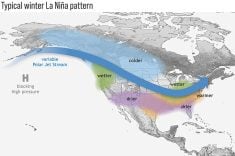For now, food grade soybeans are not a significant crop in Manitoba.
A few farmers grow them, here and there, but total acres are a fraction of all soybeans planted in the province.
That may soon change.
“I’d like to think, with the right varieties… maybe that 100,000-acre mark could be (reasonable), five, six or eight years from now,” said Sandy Hart, business manager with Sevita International, a Canadian company that develops food-grade soybean varieties and contracts production in Ontario, Quebec and Manitoba.
Read Also

Canadian Food Inspection Agency extends chronic wasting disease control program consultation deadline
Date extended for consultation period of changes to CWD program
“I’m not sure how much science is behind that but it seems like a reasonable answer,” Hart added, with a laugh.
Reaching 100,000 acres could be feasible because food grade soybeans are a substantial part of the crop in Ontario and Quebec. In 2021, farmers in those provinces seeded 3.9 million acres of soybeans. Of that, about 20 percent was food grade soybeans.
Food grade, also known as non-GMO soybeans, are used to make a variety of products, including soy milk, soy sauce, miso and tofu. Canadian food grade soybeans are exported around the globe, including to China and Japan.
Companies like Sevita need more beans because demand is expected to climb.
“The global non-GMO soybean market was valued at US$21.3 billion in 2020 and is expected to reach $38.7 billion by the end of 2027, growing at a (rate) of 8.53 percent during 2021-2027,” said marketresearch.com, in a 2020 report.
In coming years, Ontario and Quebec growers could shift more acres to non-GMO soybeans but the real opportunity for growth is Western Canada.
“The strategic goal is to diversify the geographies from which we’re contracting our (production) from,” Hart said.
“If we have a poor production season in Ontario or Quebec, and we’re short on a particular contract, we can’t just go into the market and buy non-GMO beans.”
Sevita has been trying to expand its Manitoba production for years. Its food grade varieties for Manitoba, coming to market in 2022, were part of the company’s research program about six or seven years ago.
Hart emphasized that Sevita’s focus on Western Canada isn’t a short-term effort.
“(This) is the result of many, many years of investment…. We are there to stay. We’ve got a great local distribution partner in Ceres Global Seeds,” he said. “We want to be there for the long haul… and provide some value for local growers.”
Sevita’s food grade varieties, suitable for Manitoba’s climate, have been in commercial production for a few years.
So far, the varieties have performed as expected.
“It’s been limited uptake, in terms of number of growers to date,” Hart said. “(But) those that have participated have had a good experience.”
One of those growers is Scott Perkin, who farms near Elgin, Man.
Last year, he grew 160 acres of food grade soybeans.
“We looked at their IP soybean program and they have some nice, early-maturity soybeans, which fit into our growing area,” he said. “I like the identify preserved programs… not only do they have a premium price, but there is this whole traceability aspect. The end user can trace soybeans to which field they were grown on.”
For many farmers, the most attractive part of non-GMO soybeans is the price. Sevita offers a premium over commodity soybeans of just under $2 to about $2.50 per bushel, Hart said.
Earning that premium requires extra effort.
Perkin said record-keeping is important in an IP program.
“You have to write things down,” he said. “They want to know how many units per acre you seeded and what the fertilizer was and what chemicals are being used.”
As for yield, Sevita varieties are comparable to GM soybeans, Hart said.
“We’ve been investing in data so we can show (farmers) competitive, if not equivalent or better yields, and a similar cost of production.”
Yields may be similar, but the future of food-grade soybeans in Manitoba is likely tied to the future of all soybeans in Western Canada.
Soybean acres in Manitoba and Saskatchewan have plummeted during the last four years, going from 3.1 million in 2017 to around 1.25 million in 2021. The drop was directly connected to drought.
Soybeans perform well in wet growing seasons, but the crop struggles in years with below average rainfall in July and August.
Despite the recent slump in acres, Soy Canada still has goal of six million acres of soybeans on the Prairies by 2027.
New varieties in development, with higher tolerance for weeks with minimal rainfall, could restore producer enthusiasm for soybeans.
“In any strategic plan, there’s always questions about how you’re going to get there and by what time,” said Brian Innes, executive director of Soy Canada, in early February.
“But there remains confidence for growing (more) acres in Western Canada for soybeans… There’s optimism around growth, with caution about when we’ll get there.”
















